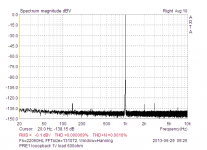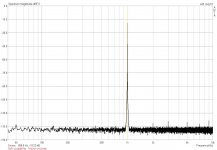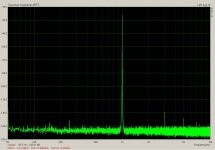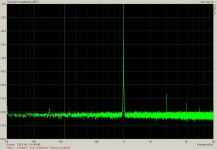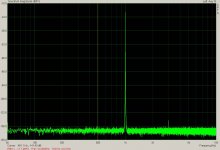The curves on the XP-30 review are pretty good but the part isn't the limitation. Distortion isn't the whole picture unless you just like the numbers. As Stefano points out it is the sound but the numbers can point you in the right direction. The Muses is my favorite solution so far. Tried lots of other chips, pots relays resistors... They all work and have been in used in successful commercial products it is always choices and trade offs.
The curves on the XP-30 review are pretty good but the part isn't the limitation. Distortion isn't the whole picture unless you just like the numbers. As Stefano points out it is the sound but the numbers can point you in the right direction. The Muses is my favorite solution so far. Tried lots of other chips, pots relays resistors... They all work and have been in used in successful commercial products it is always choices and trade offs.
100% quoting your post!! Numbers are good start however don't tell the whole story.
Therefore being only interested in pretty curves is a limiting factor when developing an high end audio product!
I will be trying this muses out pretty soon and will quote measurements and listening impression up here on this thread


Last edited:
why in the world would you use a analog volume control with a 9016/18 ESS DACwill be interesting to see the implementation in the upcoming ESS DAC.
if you are talking a hi end ESS DAC implementation you are only going to lose S/N and linearity with 10K pot, analog switch nonlinearity added in series
its hard to imagine a scenario where you couldn't spend the money, effort on the fixed gain output analog electronics of the DAC to better end with digital attenuation
Last edited:
Because I tried a lot of SS volume regulation, each was reason for worsening sound, an reasons are clearly visible in measurement (spectra, not only one number), if one know , what to look for. And because i see a lot of high harmonics, it seems , something is wrong. I want only to know, what...That is all.Why aren't you interested in how it sounds rather than looking at a pretty THD curve?
That would be my main concern, don't understand why you don't care about it!!!
For really "pretty good" measurement (and sound) i will expect totally absence of high order harmonics (higher than third), and S/N about 6-10dB better. That is my border for "good", something like in attachment
Exactly, and both is clearly visible in Stereophile test.if you are talking a hi end ESS DAC implementation you are only going to lose S/N and linearity with 10K (20k)pot, analog switch nonlinearity added in series
http://www.stereophile.com/images/413XP30fig5.jpg
http://www.stereophile.com/images/413XP30fig6.jpg
Attachments
Last edited:
@BV:
Last June you wrote in a different thread:
“Now I am using low impedance (1kohm) relay attenuator.”
Assuming that resistors and relay contacts make no contribution to distortions, this attenuator must be the perfect solution with regards to specs. You should be happy.
May be you have ears like a bat and you can hear distortions below -120dB, but this should not be the reason why you so intensely bad-mouth the MUSES-chip, ignoring that all published specs of XP30 can’t be reduced to the MUSES.
If you like it or not, John Atkinson’s final judgement about the XP30 is:
” This is a superbly well-measuring, bombproof preamplifier”
And all this despite the signal goes through the MUSES....
And if you still don’t believe Wayne and other members, that single numbers are not the whole story, have a look there to Nelson’s comments (page 4 ff):
https://passlabs.com/images/uploads/manual/Xs_amp_om.pdf
BTW: German manufacturer AVM also uses the MUSES.
Last June you wrote in a different thread:
“Now I am using low impedance (1kohm) relay attenuator.”
Assuming that resistors and relay contacts make no contribution to distortions, this attenuator must be the perfect solution with regards to specs. You should be happy.
May be you have ears like a bat and you can hear distortions below -120dB, but this should not be the reason why you so intensely bad-mouth the MUSES-chip, ignoring that all published specs of XP30 can’t be reduced to the MUSES.
If you like it or not, John Atkinson’s final judgement about the XP30 is:
” This is a superbly well-measuring, bombproof preamplifier”
And all this despite the signal goes through the MUSES....
And if you still don’t believe Wayne and other members, that single numbers are not the whole story, have a look there to Nelson’s comments (page 4 ff):
https://passlabs.com/images/uploads/manual/Xs_amp_om.pdf
BTW: German manufacturer AVM also uses the MUSES.
why in the world would you use a analog volume control with a 9016/18 ESS DAC
I don't, just curious.
No way "bad-mouth", and exactly because I know, that published specs can’t be reduced to the chip alone, I was asking about measurements for chip alone. And not for "numbers", but spectra, those can say a lot. You have to better read my posts..should not be the reason why you so intensely bad-mouth the MUSES-chip, ignoring that all published specs of XP30 can’t be reduced to the MUSES.
@ BV
congrats to these measurement plot, which I will call 'no distortion '!
What AD / DA system did you use with Arta?
I can't get such low values even in the digital loop.
Measuring the Muses
Unfortunately I can 't measure the Muses alone. The input resistance of my symmetrical measuring port is too low.
Some tests have shown that low impedance (10 kOhm ) distorted not only the characteristic of attenuation, but also a little bit of the signal.
100kOhm and higher will fit perfekt and I would still accept 47KOhm, but not 10kohms load.
And yes I will deliver good results in my own interest.
So I made a virtue of necessity, took my Sabre DAC prototype out of my listening room, my SABRE ADC was taken to the labor power supply, a select and volume board with Muses and input relay between , symmetrical of course , and then through my FET buffer and a OPA gain stage/ line driver.
The are many steps before and after the Muses. Sorry for this !
Maybe that's why we missing some zeros after the decimal point, and maybe , with the right measuring system , there are better values for the Muses,
but I can currently only deliver this.
It looks o.k. to me. (for the whole DIY Audio system , not a measuring system)
And I partly believe the data of the manufacturer also.
The level of- 18db results from the settings of the ADC-DAC (definition according to EBU R68, +4dBu = -18dBFS allignment level).
The Muses itself is set at 12db Attenuation , which is exactly what's behind amplified in the gain stage.
Now I'm looking forward to when all the parts find their way back home into my rack and listen to some records.
So stay cool when it comes to measured values, because everyone has his own experience.
It seems like everyone likes his distortion factors. Unfortunately there is no 'Zero distortion'.
In my audio system is the Muses behind the Sabre, because I also play analog records and use a volume and select board as a preamplifier.
I also use a Muses in my Sabre ADC, because I want to have a level adjustment for different analog sources here.
We don't need that in the studio but we need it for recording records and get connected to different RIAA Pre.
Even as ADC for digital crossover, the level matching at the input makes sense.
congrats to these measurement plot, which I will call 'no distortion '!
What AD / DA system did you use with Arta?
I can't get such low values even in the digital loop.
Measuring the Muses
Unfortunately I can 't measure the Muses alone. The input resistance of my symmetrical measuring port is too low.
Some tests have shown that low impedance (10 kOhm ) distorted not only the characteristic of attenuation, but also a little bit of the signal.
100kOhm and higher will fit perfekt and I would still accept 47KOhm, but not 10kohms load.
And yes I will deliver good results in my own interest.
So I made a virtue of necessity, took my Sabre DAC prototype out of my listening room, my SABRE ADC was taken to the labor power supply, a select and volume board with Muses and input relay between , symmetrical of course , and then through my FET buffer and a OPA gain stage/ line driver.
The are many steps before and after the Muses. Sorry for this !
Maybe that's why we missing some zeros after the decimal point, and maybe , with the right measuring system , there are better values for the Muses,
but I can currently only deliver this.
It looks o.k. to me. (for the whole DIY Audio system , not a measuring system)
And I partly believe the data of the manufacturer also.
The level of- 18db results from the settings of the ADC-DAC (definition according to EBU R68, +4dBu = -18dBFS allignment level).
The Muses itself is set at 12db Attenuation , which is exactly what's behind amplified in the gain stage.
Now I'm looking forward to when all the parts find their way back home into my rack and listen to some records.
So stay cool when it comes to measured values, because everyone has his own experience.
It seems like everyone likes his distortion factors. Unfortunately there is no 'Zero distortion'.
In my audio system is the Muses behind the Sabre, because I also play analog records and use a volume and select board as a preamplifier.
I also use a Muses in my Sabre ADC, because I want to have a level adjustment for different analog sources here.
We don't need that in the studio but we need it for recording records and get connected to different RIAA Pre.
Even as ADC for digital crossover, the level matching at the input makes sense.
Attachments
2 spiri
Thank You for measurement, here is enough information for me. Nearly the same spectra picture as in other measurement, with dominant odd order harmonics , not decreasing with frequency. So it seems, it is inherent to chip. Slight differencies probably due other (inevitable..) active circuits. Sensitivity to load points to SS switches nonlinearity, a little bit higher noise background, about the same as other SS volume regulators . How it is important, is very subjective decision. For me, it is good (slightly better linearity as other similar circuits), but not enough for top notch performance.
I use Lynx L22 soundcard. In digital loop there should (must) be by about 25dB lower noise background for the same FFT setting (for 24 bit resolution).What AD / DA system did you use with Arta?
I can't get such low values even in the digital loop.
Thank You for measurement, here is enough information for me. Nearly the same spectra picture as in other measurement, with dominant odd order harmonics , not decreasing with frequency. So it seems, it is inherent to chip. Slight differencies probably due other (inevitable..) active circuits. Sensitivity to load points to SS switches nonlinearity, a little bit higher noise background, about the same as other SS volume regulators . How it is important, is very subjective decision. For me, it is good (slightly better linearity as other similar circuits), but not enough for top notch performance.
Last edited:
The curves on the XP-30 review are pretty good but the part isn't the limitation. Distortion isn't the whole picture unless you just like the numbers. As Stefano points out it is the sound but the numbers can point you in the right direction. The Muses is my favorite solution so far. Tried lots of other chips, pots relays resistors... They all work and have been in used in successful commercial products it is always choices and trade offs.
Wayne, congrats with the brilliant review your design received from Stereophile!
Very interesting subject here where I end up looking at new nuforce MCP-18 multichannel preamp volume control.
Interesting because I did some time ago some evaluation of few volume control solutions in a DIY preamp having in mind high quality multichannel analog.
I am always looking then at new solution and this MUSE is definitely something I should try.
So far the best solution I was able to build and listen is based on DS1882 which is also a good solution as Wayne mentions beginning of this topic.
I had exactly the same approach as highlighted here, a simple resistor ladder without any opamp, I did not want opamp.
The DS1882 is followed by a UGS gain stage in balanced implementation and well the combination sound fantastic, really good, I love this preamp.
Some link here to see the mockup (sorry for the French but photos are self speaking), I could not do the casing so far because I was not able to unplug it since it sounds so good
Le sujet Preampli multicanal UGS+DS1882 & CS3308 du forum Travail de Groupe - DIY sur HCFR
You will see as well some trial with CS3308 but nothing to the level of DS+UGS so I just abandon it.
I will try this MUSE in replacement as my DS1882 (I used headers to easily swap PCB) using only the attenuation block, well exactly as the DS1882 is actually , just to understand how the MUSE sounds.
, just to understand how the MUSE sounds.
Interesting because I did some time ago some evaluation of few volume control solutions in a DIY preamp having in mind high quality multichannel analog.
I am always looking then at new solution and this MUSE is definitely something I should try.
So far the best solution I was able to build and listen is based on DS1882 which is also a good solution as Wayne mentions beginning of this topic.
I had exactly the same approach as highlighted here, a simple resistor ladder without any opamp, I did not want opamp.
The DS1882 is followed by a UGS gain stage in balanced implementation and well the combination sound fantastic, really good, I love this preamp.
Some link here to see the mockup (sorry for the French but photos are self speaking), I could not do the casing so far because I was not able to unplug it since it sounds so good
Le sujet Preampli multicanal UGS+DS1882 & CS3308 du forum Travail de Groupe - DIY sur HCFR
You will see as well some trial with CS3308 but nothing to the level of DS+UGS so I just abandon it.
I will try this MUSE in replacement as my DS1882 (I used headers to easily swap PCB) using only the attenuation block, well exactly as the DS1882 is actually
Wayne, congrats with the brilliant review your design received from Stereophile!
Thank you. John did his usual thorough job.
2 spiri
I use Lynx L22 soundcard. In digital loop there should (must) be by about 25dB lower noise background for the same FFT setting (for 24 bit resolution).
Thank You for measurement, here is enough information for me. Nearly the same spectra picture as in other measurement, with dominant odd order harmonics , not decreasing with frequency. So it seems, it is inherent to chip. Slight differencies probably due other (inevitable..) active circuits. Sensitivity to load points to SS switches nonlinearity, a little bit higher noise background, about the same as other SS volume regulators . How it is important, is very subjective decision. For me, it is good (slightly better linearity as other similar circuits), but not enough for top notch performance.
Your last statement has left me restless and I have optimized my ADDA system to see what it is all about.
I have trimmed the DC-Offset at the ADC and use the SABRE DAC in voltage mode (Master Trimm set to -12dB), so I turned off the OPA1632 i/V Stage.
Maybe there is a little more noise after this. See Sabre DA_AD_without_Muses.jpg
The Gain off my preamplifier after the muses is increased by 6dB.
The attunation off my Volume and Select Board is set once to -6dB and once to -18dB.
You see, the distortion depends not only on the Muses.
Adding little noise can not be avoided.
Thanks that you instigated me to do some more measurements.
I hope it's all right that this discussion is out here and not in the vendor thread.
Attachments
I don't understand why this IC is taking dual rail supply since it's passive.
My most concern wouldn't be why there is double supply, why its distortion is .0002% instead of .00000001%...or why it is an IC instead of looking like a DACT....and so on....but more how does it sound?
If this device really sounds great, why would anybody really care about all the issue brought up above? In the other hand if it sounds bad, it shouldn't even be taken in consideration and then who cares about it anyway?
So I am asking people here to just stay tuned as I am reviewing it here for everybody's benefit and a full description will come out as soon as I feel I am ready to have a full and fair picture of the device!
All I can say so far, is that this review will be extremely interesting!...just be patient a little more!
- Home
- Source & Line
- Analog Line Level
- MUSES 72320 electronic volume
